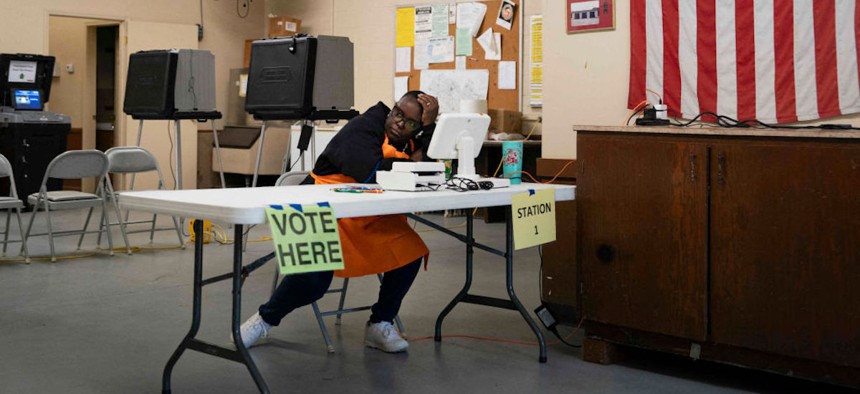Feds preach vigilance amid multiple physical, cyber threats against election officials

A poll worker sits at a desk at a polling location during the South Carolina Democratic Primary on Feb. 3, 2024, in Orangeburg, South Carolina. ALLISON JOYCE/AFP via Getty Images)
In response, agencies as varied as CISA and the Postal Inspection Service are offering a slew of free and low-cost resources in a bid to help states and localities keep issues under control.
Seemingly everywhere elections officials turn, a new threat comes into view.
Recent research from the Brennan Center for Justice found that officials across state and local government, including elections officials, have received all manner of abuse including insults, harassment, threats and physical attacks.
Last November, for instance, those threats became all too real. Elections offices in at least five states—California, Georgia, Nevada, Oregon and Washington—were sent suspicious letters, which delayed ballot counting in some local races. Four of the letters contained fentanyl, according to the FBI and the U.S. Postal Inspection Service, which had intercepted them.
In addition to physical threats, elections officials are also dealing with ongoing worries about cybersecurity, ransomware attacks and the role artificial intelligence could play in both facilitating those and misinformation campaigns.
It all leads to plenty of anxiety-inducing moments for elections officials across state and local government. But two federal agencies want to help.
Earlier this month, officials from the Cybersecurity and Infrastructure Security Agency and Postal Inspection Service shared how they plan to help state and local officials at winter meetings for both the National Association of Secretaries of State and the National Association of State Election Directors in Washington, D.C.
Any support is welcome news. Last week, county officials were told at their winter meeting in Washington not to expect more funding from Washington.
Eric Goldstein, executive assistant director for cybersecurity at CISA, told secretaries of states that the agency is stepping up its protection efforts for the upcoming presidential election. It will have election security advisors in each of its regional offices, in an effort that Goldstein said is part of CISA’s desire to be a “field first agency” like the FBI, not centralized in Washington.
David Stafford, CISA election security advisor for region 4 in the Southeast, said during a session for election directors that while he and his peers are “still in the touching base phase,” the vision is to “act as a translator both upstream and downstream,” imparting information from on the ground to headquarters, and disseminating initiatives from central office to the local level.
Tim Langan, executive assistant director for the FBI’s Criminal, Cyber, Response and Services Branch, said there are “myriad types of threats” facing elections, including cyberattacks and foreign influence campaigns. Many attacks revolve around stealing voters’ personal information, he added.
Some have somewhat downplayed the threat of cyberattacks on elections this year and said that disinformation and misinformation driven by artificial intelligence should be more concerning. In its annual Global Threat Report, cybersecurity company CrowdStrike said disruptions are more likely to come from nation states looking to sow discord rather than attack systems.
Adam Meyers, CrowdStrike’s senior vice president for counter adversary operations, said cybersecurity risks are lower for election equipment as it typically is not connected to the internet. Election workers should still be vigilant for information being hacked and leaked online, especially through phishing attacks.
Physical threats against election offices and workers also are causes for concern among state leaders, especially as they wrestle with a retiring workforce and fewer people willing to step up. Langan said the FBI is devoting lots of “energy, resources and focus” on the 2024 elections in a bid to stay ahead of any threats, especially against polling places.
Mail-in voting will also be critical, said Brendan Donahue, assistant inspector in charge at the U.S. Postal Inspection Service. The United States Postal Service delivered 135 million ballots to and from voters in 2020, Donahue said during a session with secretaries of state, and another 54 million in 2022. That figure does not include campaign literature, he added.
But the events of last November meant mail-based threats “came to the forefront,” he said. Donahue urged every election office to have a plan to screen its mail, not just from USPS but also private carriers like FedEx and UPS.
Being ready for the worst-case scenario is key.
“We all hope there isn’t going to be an incident, but we have to prepare for if there is,” Keith Ingram, a CISA election security advisor for region 6 in the South of the U.S., said during a session for election directors.
“The word vigilance is almost overused, but I don’t know a better word to use,” said Kansas Secretary of State Scott Schwab, referring to the constant state that elections officials must be in amid these myriad threats.






